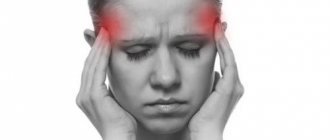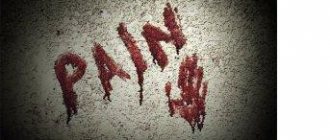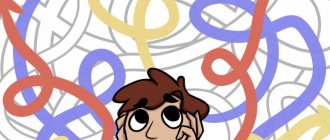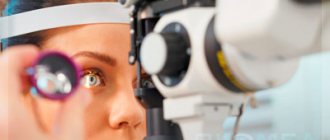When a person experiences prolonged stress or the body is overcooled, he may feel pain in the back and chest area under the shoulder blade. Most often, sensations of quite severe pain are accompanied by motor difficulties. It is difficult to turn, bend, make any movements, even breathe fully. It is generally accepted that the person was shaken, turned the wrong way, or something got under his shoulder blade. In fact, from a medical point of view, all this has one reason - a pinched nerve, which is not actually a diagnosis.
What to do if a nerve is pinched under the scapula
Why does a nerve become pinched?
For what reason does pinching occur, and why specifically in the shoulder blade? After all, there are nerves throughout the spine. This is true, but it is in the thoracic area, where the shoulder blades are located, that the nerves are most susceptible to various influences. Second in line is the back, which is supplied with lumbar nerves. A person may also experience pain in the shoulder, collarbone and neck when the nerves of the cervicothoracic area are pinched.
Pain may radiate to the neck
This diagnosis is noteworthy in that a person often makes it himself, saying that a nerve is pinched, and a compress or poultice at home, without bothering to see a doctor, or it will go away on its own. And in most cases, especially if the scapular nerve is inflamed due to hypothermia, the pain actually begins to subside the very next day.
Prices for painkillers for back pain
Important! But a pinched nerve in any part of the spine is a symptom that needs to be addressed by a doctor. No pain arises in the body just like that. And the diagnosis signaled by this symptom can only be established by a medical professional.
The cause of the pain must be determined by a doctor
It’s worth starting to understand the problem with the question: how does pinching occur? It occurs due to the fact that the nerve is compressed by the tissues surrounding it. This can be bone or cartilage tissue, muscle or tendon tissue. For this reason, pain can occur at any spinal level.
By the way. Nerves can become pinched not only in the spine; facial, radial, ulnar nerves and so on can also be pinched, causing pain in the corresponding organs.
The disease is spread throughout the body and occurs in a large percentage of patients, but as such there is no diagnosis of “pinched nerves”. This is because it is not a disease, but only a symptom of it. And not even one, but many diseases. This is why diagnosis is important to identify the cause of the pinched nerve.
It is important to undergo an examination and find out the cause of the pinched nerve.
Why a nerve may become pinched:
- due to injury;
- due to tumor;
- a growth forms on the bone tissue;
- the patient leads a sedentary life;
- he experiences excessive stress;
- there is an intervertebral hernia;
- osteochondrosis is present;
- hypothermia occurs;
- disc protrusions are formed;
- this is a consequence of arthrosis;
- the patient has arthritis;
- gastrointestinal diseases;
- there are diseases of the endocrine system;
- tumor-like formations;
- history of an autoimmune disease.
The nerve can be pinched due to herniated discs, as well as for many other reasons.
As you can see, there are many reasons for a nerve to be “pinched.” There are also indirect accompanying circumstances that will help or provoke the process. Excess weight and old age, damage to posture and hereditary factors, as well as pregnancy, are called provoking factors.
Nerves can become pinched during pregnancy
The following can directly cause an attack of pain from a pinched nerve:
- lifting weights, if you do it abruptly or take significant weight;
- a certain position that is not comfortable that a person takes during sleep;
- sleeping on a mattress that is too hard/soft or of poor quality;
- being in a draft, wind, or low temperatures;
- overeating with existing obesity;
- injury to the back or chest.
A nerve may be pinched due to an uncomfortable posture during sleep.
These reasons are secondary. And, unlike the list of reasons given above, they are much easier to deal with. In a short time it is possible to return to your normal life and stop experiencing pain. If the problem is a disease, then the patient must undergo long-term complex therapy so that pinching does not recur.
Important! Neither in the second, nor even more so in the first case is it possible to self-medicate. Yes, if constriction occurs for a secondary reason, it is enough to limit yourself to ointments, compresses and certain medications, but in order for them to be prescribed correctly, you need to go to the doctor.
How to relieve pain under the right shoulder blade
If pain in the scapula area is associated with diseases of the spine, muscles or injury, then painkillers should be taken as first aid. For this purpose, non-steroidal anti-inflammatory drugs or NSAIDs are most often used. They effectively fight pain of any origin, suppressing inflammatory reactions. However, uncontrolled and long-term use of NSAIDs increases the risk of side effects of this group of drugs, such as stomach ulcers, gastric bleeding or kidney failure. Therefore, without a doctor’s prescription, it is permissible to take analgesics for no more than 5 days, after which you must consult a doctor for diagnosis and treatment.
Local remedies in the form of distracting and analgesic ointments, gels and patches do not have such side effects, since this dosage form is limited to the area of application. They help especially well with myositis, muscle strain, attacks of neuralgia and other diseases with chronic pain syndrome. In diseases of the spine, pain can be relieved by rest, limiting physical activity and prohibiting heavy lifting.
It is strictly forbidden to use painkillers if you suspect acute cholecystitis, pancreatitis and other diseases of the abdominal organs that require emergency surgery. Taking painkillers in such patients can lead to temporary relief of symptoms and a false sense of improvement, which ultimately contributes to late presentation and serious condition of the patient due to extensive inflammation of the peritoneum or peritonitis.
If pain in the area of the shoulder blade on the right occurs against the background of severe abdominal pain, accompanied by fever, nausea, and vomiting, you must seek medical help as quickly as possible.
Shpidonov Gennady Stanislavovich
Neurologist
Rostov State Medical University (neurology)
10 years of experience
How does the patient feel?
How can you understand that the pain that has overtaken a person is due to compression of the nerve? According to symptoms. You need to know that there are different types of nerves. And depending on the type of damage, the strength, speed of occurrence and duration of pain are determined.
Important! If a sensory nerve is pinched, severe pain will immediately occur, which can hardly be tolerated, and motor functions will be impaired. If the motor or autonomic nerve is damaged, the pain will come some time later, will be deep and aching, and the damage will affect the internal organs and the vascular system.
- The main symptom of a pinched sensory nerve in the area of the scapula is severe pain that occurs suddenly and has a stabbing, cutting, piercing nature. They can “shoot through” and “burn”. They will hit you under the shoulder blade or in the shoulder, as well as in the arm.
- Motor function will be impaired, that is, turning the body, bending, raising arms and other movements will be performed with great difficulty and will be accompanied by increased pain.
- The back muscles under the shoulder blade may become stiff and feel tight.
- An unpleasant feeling of heaviness in the heart area may appear, which does not go away even when the patient takes a horizontal position and tries to rest.
- Headache and numbness of the hands are not mandatory, but possible side symptoms.
Stitching pain under one or both shoulder blades, often radiating to the arm
Features of symptoms
Nerve endings run from the spinal cord throughout the body. They reach every muscle, so a person often experiences pain not only at the site of a specific pinched nerve.
The nerve may be pinched under the scapula or between the vertebrae located at the level of the scapular line, or in almost the entire cervicothoracic area of the spine.
However, most often in the area of pinching the pain is most intense. And since the shoulder blade, especially the left one, is located at the level of the heart region (although some heart diseases and their attacks can cause pain on the right side), painful sensations can easily be mistaken for manifestations of cardiac pathology.
When a nerve is pinched, the pain can be confused with heart pain.
Advice. If there is pain in the shoulder blade, under it or near it, on both the left and right sides, especially if the syndrome is intense, difficult to tolerate, or too sudden, you should go to the doctor immediately. If this is not possible, and the pain intensifies, you need to drink a painkiller, take a horizontal hard surface and call an ambulance.
Treatment of pain on the right side of the shoulder blade
Pain treatment must begin with diagnosis, since effective pain management is only possible if you know its cause. Symptomatic therapy based on the use of analgesics does not treat the cause of pain, but only temporarily alleviates the most severe symptom. After making an accurate diagnosis, it is possible to treat the underlying disease by influencing the factors that led to it.
This is also important because without knowing the cause of the pain, it is difficult to choose the right treatment. Thus, attempts to treat pain in the scapula on the right side with analgesics in acute cholecystitis can lead to complications in the form of gangrene of the gallbladder, its perforation and extensive peritonitis, with a high risk of death. Painkillers are strictly contraindicated for acute surgical diseases of the abdominal organs.
Other diseases - clinics in
Choose among the best clinics based on reviews and the best price and make an appointment
Family
Scoliosis Treatment Center named after K. Schroth
Moscow, st.
Azovskaya, 24, building 2 POM VI/KOM 5,6,7/ET 1 Sevastopolskaya
+7
- Consultation from 1500
- Exercise therapy from 2700
0 Write your review
Family
Oriental Medicine Clinic "Sagan Dali"
Moscow, prosp.
Mira, 79, building 1 Rizhskaya
+7
- Consultation from 1500
- Diagnostics from 0
- Reflexology from 1000
0 Write your review
Family
Center for Chinese Medicine "TAO"
Moscow, st.
Ostozhenka, 8 building 3, 1st floor Kropotkinskaya
+7
- Consultation from 1000
- Massage from 1500
- Reflexology from 1000
0 Write your review
Show all Moscow clinics
Diagnostic methods
Since scapular neuralgia develops under the influence of numerous factors, the symptoms are similar to the manifestations of other diseases, so pain in this area will require a comprehensive examination of the patient. In order to establish the causes of discomfort under the shoulder blades, the following are prescribed:
- MRI and CT scans, which help detect the presence of tumors, spinal deformities or bone spurs;
- electromyography, which allows you to assess the condition of nerve fibers;
- external examination of the body;
- a general blood test to identify the inflammatory process in the body.
If there is a suspicion of a pinched nerve in the scapula, an additional test is used.
During this diagnostic procedure, electrodes are connected to the skin, through which a low-intensity current is applied. In some cases, additional research will be required to help identify the causes of neuralgia.
Other diseases - specialists in Moscow
Choose among the best specialists based on reviews and the best price and make an appointment
VertebrologistOrthopedist
Gromov Ilya Sergeevich
Moscow, st.
Azovskaya, 24, building 2 POM VI/KOM 5,6,7/ET 1 (Scoliosis Treatment Center named after K. Schroth) +7 Registration
0 Write your review
VertebrologistOrthopedist
Kudryakov Stepan Anatolievich
Moscow, st. Azovskaya, 24, building 2 POM VI/KOM 5,6,7/ET 1 (Scoliosis Treatment Center named after K. Schroth)
+7
Registry
0 Write your review
Orthopedist
Prevention
To avoid exacerbation of pain when pinched in the scapular region, it is recommended to use an orthopedic mattress while sleeping and wear warm clothes in winter (cold often causes relapse of neuralgia). Also, to prevent the disorder, it is better to avoid lifting heavy objects.
Patients with endocrine pathologies are prescribed to follow a diet, and those with osteochondrosis are prescribed to visit a doctor at certain intervals.
In addition, to prevent exacerbation of pain under the shoulder blade, it is recommended to regularly perform a complex of exercise therapy and attend massage sessions.
Symptoms accompanying painful manifestations
Using additional signs, you can quickly identify the cause of pain between the shoulder blades.
A feeling of numbness in the back appears against the background of:
- osteochondrosis;
- curvature of the spinal column;
- humeroscapular periarthritis;
- pleurisy;
- cardiac ischemia;
- biliary dyskinesia.
The appearance of itching in the back area is characteristic of diseases such as herpes zoster and biliary colic. If a feeling of chills occurs, we can talk about an exacerbation of pyelonephritis or infringement of nerve receptors in the spinal canal.
High temperature is characteristic of pathologies of internal organs:
- pancreatitis;
- pneumonia;
- tuberculosis;
- hepatitis;
- cholecystitis;
- jade.
Cough syndrome in combination with pain in the interscapular area appears against the background of problems with the lungs and bronchi. A typical symptom of impaired pulmonary function is difficulty breathing.
The appearance of vomiting is characteristic of peptic ulcers in the stomach, liver and kidney diseases, and myocardial infarction. The appearance of belching may indicate damage to the upper digestive tract.
Pain in the interscapular region is only a symptom. To achieve positive results and eliminate discomfort, you need to begin treating the underlying disease.
Drug therapy
The correct choice of drugs is no less important for the treatment of a pinched nerve. Among medications with analgesic and anti-inflammatory effects, you can choose Ibuprofen or Diclofenac, preferably in the form of an injection to obtain the best result. Ketonal is suitable for pregnant women.
There are many types of ointments, for example, Karmalis eliminates pain, and Betalgon, in addition to relieving discomfort, improves blood circulation. If you need a product with a warming effect, then it is better to purchase Viprosal, which is also an analgesic, and Flexen is excellent for inflammation.
Each drug must be used as prescribed by your doctor. Using medications on your own, along with insufficient effect, can lead to adverse reactions and complications.
If an inflammatory process occurs in the muscles, then it is necessary to undergo a course of treatment with anti-inflammatory drugs, such as
The inflamed area also needs external medications:
- hydrocortisone ointment;
- Fastum-gel;
- indomethacin ointment;
- Diclaggel.
When the inflammation subsides, you can use external medications that irritate the nerve endings: “Zvezdochka”, Menovazin and others. In the third week, it is worth switching to drugs that affect blood vessels, such as Nicroflex.
If after the first week of treatment there are no changes in a positive direction, immediately contact the hospital.











